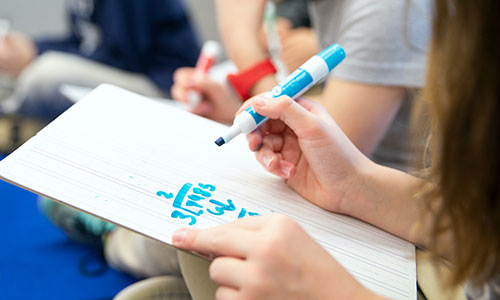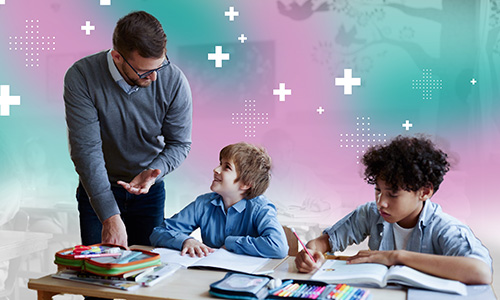
Improvised comedy, or improv, for short, is the art of creating a scene from nothing but a suggestion, often with a scene partner or group. Great improv will leave audience members wondering if the scene were scripted. But this is impossible because scenes start with a suggestion from the audience. I love using improv in the classroom to get my students excited about math.
I’ve performed comedy since 2018, starting with stand-up before I shifted to improv and sketch comedy. I’ve turned often to Tina Fey’s book Bossypants, in which she says, “In improv there are no mistakes, only beautiful happy accidents. And many of the world’s greatest discoveries have been by accident.”
I’d like to pass along four rules of improv from her book that can also be applied in the classroom to get kids energized about learning.
Rule #1: Say “yes”
Yes is a mindset of openness and readiness to a moment’s offering. Only when we are in a state of perpetual “yes” are we truly open to another person. However, “yes” indicates acceptance, not necessarily agreement. In improv, a scene might start like this:
Wife: You never take me out on dates anymore.
Husband: I took you to Chuck E. Cheese last week!
You can see in this example that the actor playing the husband accepts the establishment of a relationship gone stale by disagreeing with the wife’s claim.
In her LinkedIn Learning course “Harnessing change to unleash your potential,” Anastasia Montejano talks about acceptance, too. She explains that it’s on a continuum: deny, resist, explore, accept.
Consider where you might be on this continuum when it comes to your classroom. You can apply this first rule of “yes” to accept reality and the hand that’s been dealt to you. “Yes” might mean:
- I’ve got 18 out of 25 students who are below grade level for math
- I’ve got a first-year co-teacher
- I’ve got a veteran co-teacher
- Administrators are implementing three new initiatives this year
The quicker you can accept your reality with openness and curiosity, the easier it will be to succeed because everything will be an opportunity.
Rule #2: Actively listen through “Yes, and…”
Once I’ve accepted what my scene partner has established, I can build on it. There’s a saying in improv: “Bring a brick, not a cathedral.” My scene partner can’t read my mind so I can’t create a whole scene in my head (a cathedral) and try to play that out. My partner can only react to the one line I say or one action I do (the brick). And—together—we get to build our own cathedral. This implies that, as an actor, I have to actively listen to what my partner is saying before I respond and react to the last thing that was said.
Consider what trying improv in the classroom and embracing both positivity and active listening might look like. Do you find yourself waiting for students to be done sharing, or are you reacting in real time to what they are saying? The challenge for teachers is that we often know the cathedral (the scope and sequence) that is being built. How can we lay bricks alongside students and build a cathedral together?
One practical suggestion is to facilitate listening-centric experiences with students. I encourage you to use our formative conversation starters to try this in your classroom.
Rule #3: Make statements
Generally, great improvisers can establish the location, characters, and relationship within the first three lines of dialogue so that they can take the rest of the time to play. Actors do this by giving a gift, which is setting something up in the scene for other actors to react to.
Gifts are often given through clear statements and specific details, rather than questions. For example, instead of a character saying, “Where are we going?” a character might say, “Ugh, I hate going to the mall this late.” Can you see the difference in how these two scenes might play out? The first scenario presents a situation where the second actor isn’t given a lot to work with. The second scenario establishes the actors are going to the mall at a late hour.
Additionally, providing specific details is often funnier than supplying generic information. For example, instead of saying, “Wow, I can’t believe you bought my dream car,” a character might say, “Wow, I’ve always wanted a Hyundai Sonata.” Something about the specificity of the car makes this scene funnier. No one’s dream car is a Hyundai Sonata (I think?). The character has offered a gift to their scene partner with this detail.
When using improv in the classroom, you can provide gifts for students with clear expectations through learning statements and success criteria. Learning statements share the expectation of cognitive understanding. Success criteria share the expectation of actions students need to take to show their cognitive understanding, since we can’t read their minds.
As teachers, we should be mindful of the assessments we provide. We want to be sure they are intentional, rather than just for a grade. Then, will we use formative or summative assessment? How will the assessment inform teachers of what students know and don’t know? What will we do with the information students provide on assessments?
Less ambiguity will decrease anxiety for learning, on both sides. For teachers, getting transparent means getting honest about our own goals, and it helps us locate exactly where our students can join us in collaboration. If we can show our learners the game plan, then they might be more inclined to take ownership of their academic growth—and then make their own suggestions.
Rule #4: Remember: There are no mistakes
As Tina Fey noted in her book, there are no mistakes, only opportunities. She was talking about improv, but I think her wisdom applies to teaching, too.
In improv, I must often let go of what makes sense. After all, that’s just what “makes sense” to me. A scene might play out that I’m a talking pencil trying to get out of a pencil case with my best friend, the highlighter. If I can surrender the rules of life, then I can play more freely and creatively.
Usually when I perform, I evaluate my soft skills and not the content. In other words, I don’t reflect on what I should have said or done; rather, I focus on how well I supported my scene partner and embodied my presence. Maybe there’s a character I want to try out or I need to work on eye contact. These are the skills that will help me become a better improviser.
Similarly, as a teacher, I aim to listen to my students and understand their point of view. I help them explore ideas in different ways. And I try to remind myself—and them—that we should “Embrace mistake-making in math.”
The funny will come
Another frequent saying in improv is, “Don’t force the funny. The funnies will come.”
Teachers, don’t force the learning. The learning will come. It might come today, tomorrow, next week, or next semester. Keep trying and exploring and moving on when something doesn’t go according to plan. Think about ways you might use improv in the classroom. “Bad” lessons don’t define your value as a teacher. In Tina Fey’s words, bad lessons can be “beautiful happy accidents.”
To hear more about this topic, listen to our The Continuing Educator podcast episode “Comedy and the classroom, with Nicholas Joe.”







